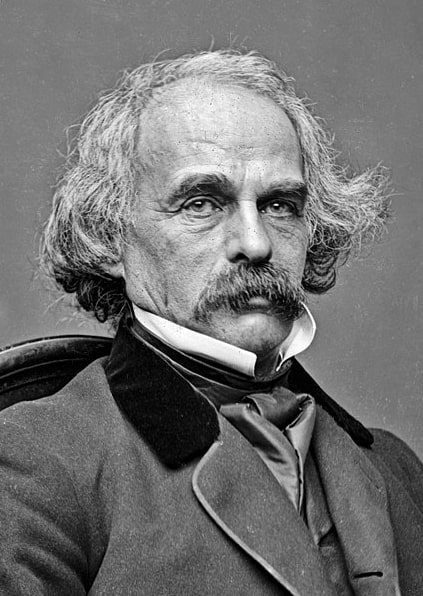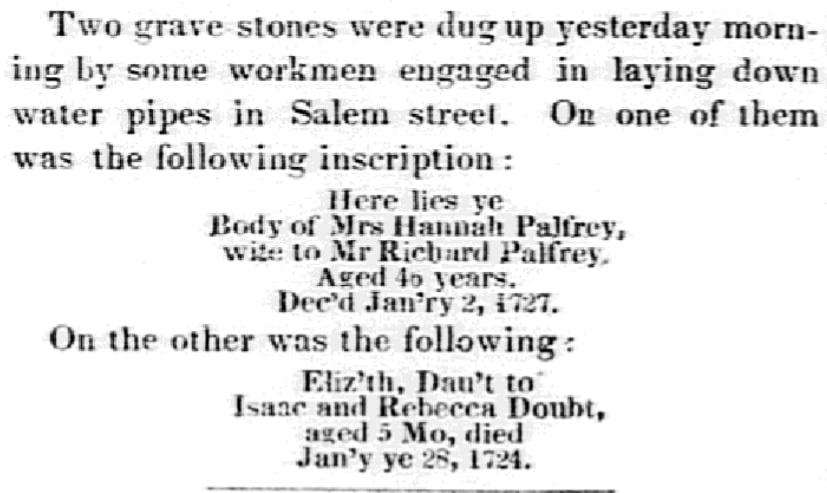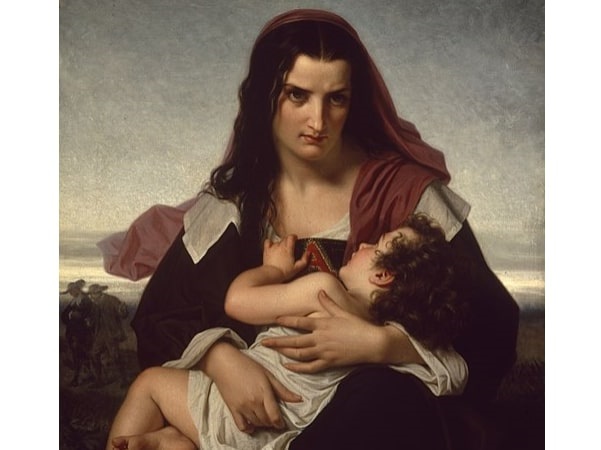Introduction: In this article, Melissa Davenport Berry presents another story from the family line of author Nathaniel Hawthorne, this one having a possible connection to “The Scarlet Letter.” Melissa is a genealogist who has a blog, AnceStory Archives, and a Facebook group, New England Family Genealogy and History.
“If truth were everywhere to be shown, a scarlet letter would blaze forth on many a bosom besides Hester Prynne’s.”
–Nathaniel Hawthorne, The Scarlet Letter

My last story explored the family background and sources Nathaniel Hawthorne used for his novel The House of the Seven Gables. In my continued research, I came across a court case that perhaps provided a hot source for Hawthorne’s novel The Scarlet Letter. Also, the Manning family case here is a genealogy link to his maternal ancestral line through his mother Elizabeth (Betsey) Clarke Manning.
First, some background: in April 1847 two gravestones were dug up by some workers laying down water pipes in Salem Street, Boston, Massachusetts.

The inscription on Mrs. Hannah Palfrey’s gravestone reads:
Here lies ye
Body of Mrs. Hannah Palfrey,
Wife to Mr. Richard Palfrey,
Aged 46 years.
Dec’d Jan’ry 2, 1727.
I researched the genealogy of Mrs. Hannah Palfrey, which led to the discovery of an illicit sex scandal surrounding her husband’s family that shocked the Puritan community in Salem, Massachusetts (where Nathaniel Hawthorne was later born).
Mrs. Hannah (nee’ Harris) Palfrey married Richard Palfrey in Salem in 1704. Richard was born to Walter Palfrey and Margaret Manning of Salem, who married in May 1680.
The families were considered pillars of Puritan society – but while Margaret was carrying Richard, she and her sister Antice were convicted of “incestuous carriage” with their brother Captain Nicholas Manning.
The three Manning siblings were born to Richard and Antice Manning. Another sibling, Thomas (a twin to Jacob), was the 2nd gr. grandfather to Nathaniel Hawthorne.
Nicholas was a respected citizen, successful mariner, and skilled gunsmith. He served as soldier, constable, and selectman. In 1667 he made a name for himself as commander of the ketch Supply.
Nicholas married Elizabeth (nee’ Wickes) Gray, a widow much older than he. She brought children into the marriage, fathered by Robert Gray.
By 1680 Nicholas and Elizabeth’s marriage was not harmonious, and she then unleashed the purposive, shocking charge of his incestuous relationships with his sisters. The case carried little merit and most of the evidence came from hearsay.
Elizabeth testified that she lived in terror from the Manning family and was forced to retreat to her daughter’s home. She claimed she was living in poverty and petitioned the court to seize all assets of Nicholas’ estate, or else she would be on the dole.
Two of Elizabeth’s daughters, Elizabeth Priest and Bethia Allen, gave testimony that did not support evidence of the alleged crime. However, the court brought down indictments on all three of the Manning’s.
You can read the transcribed court files on the University of Virginia website “Records and Files of the Quarterly Courts of Essex County Volume VIII.”
Part of the court transcription reads as follows:
“Anstis [Antice] Manning and Margert Manning, now Palfrey, for incest, their brother Nicholas Manning being implicated, were committed to prison until morning, and then at Ipswich to be whipped upon the naked body. At the next lecture day at Salem they were to stand or sit upon a high stool during the whole time of the exercise in the open middle alley of the meeting house, with a paper upon each of their heads, with their crime written in capital letters [INCEST, My Whorish Carriage], the constable of Salem to see it performed.” (p. 87-88)
Margaret and Antice were found guilty and made to suffer a punishment of public humiliation known as “branding.” The magistrates had mercy on the sisters and allowed them to pay a fine instead of being whipped – and may have even questioned their guilt, because branding was intended to be permanent in most cases. Their brother Nicholas, meanwhile, had fled.
Hawthorne’s character Hester Prynne in the The Scarlet Letter had to permanently wear an embroidered red “A” (for Adultery) on her dress upon her breast, a form of “branding.” Although they were not branded, it is certain the Manning sisters felt slighted and degraded by society even without the reminder stamped on their bosom.
Stay tuned for more on the Manning scandal…
Related Article:
